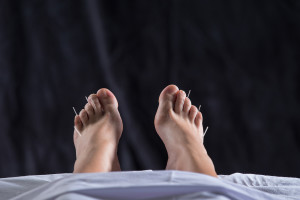Onychomycosis…Huh? Yep, that’s right, you’ve seen it on your friends, family members, and maybe even you have it. So, what is it? TOE NAIL FUNGUS! It is the least common form of tinea unguium in healthy people and found more commonly when you are immunocompromised. What does this all mean? Are there any alternative treatments that can help get rid of it instead of putting a toxic substance on the nail or in the body that could leech into the blood stream?
- Lets start with the risk factors; do you perspiring heavily, work in a humid or moist environment, have a skin condition like psoriasis, wear socks and shoes that don’t absorb perspiration? Do you walk barefoot in damp public places? Have athlete’s foot (tinea pedis)? Or, have a minor skin or nail injury, a damaged nail or another type of infection? Lastly, do you have diabetes, circulation problems or a weakened immune?
If you answered yes to any of these risks then your next mission is to look down, how do your toes look? See any discolouration or cracks or thick hard to cut nails? Yes, Yes, and Yes! To treat nail fungus, your doctor may prescribe an oral antifungal medication such as terbinafine (Lamisil) and itraconazole (Sporanox). These medications are taken for at least six weeks up to a year and beyond. Recurrent infections are always possible, especially if you continue to expose your nails to warm, moist conditions. These Antifungal drugs have some serious side effects ranging from skin rashes to liver damage. Doctors may not recommend them for people with liver disease or congestive heart failure or for those taking certain medications. Another possibility is an antifungal nail polish called ciclopirox (Penlac). You paint it onto your infected nails and surrounding skin once a day, but again it comes with risks. For a cleaner/natural option choose socks that are made of natural fibers (cotton or bamboo), rotate through a few pairs of shoes to allow them to properly dry, be barefoot at home, wash your feet daily and dry them properly after, avoid wearing nail polish or artificial nails. If you don’t manage these conditions, you risk having recurrent infections. Seeing a Certified Master Pedicurist (CMP) that is certified through the North American School of Podology every 6 to 8 weeks for a pedicure. A CMP is trained to recognize foot conditions and can help by reducing the thickness of the nails and helping remove excess fungus. Using Footlogix’s Antifungal Tincture which has spiraleen, derived from a natural micro-algae called spirulina, whose anti-fungal, anti-viral and anti-bacterial properties help to minimize the fungal culture and support a stronger skin barrier without disrupting the skin’s natural flora.
The reality of this issue is that a fungus is a fungus inside and out. If you are weak, tired, or having surgery, your immune system is already challenged. Meaning that nothing will help you clear up the fungus until you’ve dealt with the deeper issue. You need to take care of the internal conditions that may be interfering with your healing. Consider making some dietary changes, such as avoiding foods that make yeast, mold and fungus grow like fermented foods, tofu, breads, and sugar. Adding a general detoxification program that focuses on reducing yeast in the body. If you are weak and tired, are diabetic or have an immune system that is already challenged, build up your immunity with therapies like acupuncture with a Registered Acupuncturist (R.Ac) and reduce your stress levels. To fight fungus, you need to take care of yourself, inside as well as outside.



Sorry, the comment form is closed at this time.